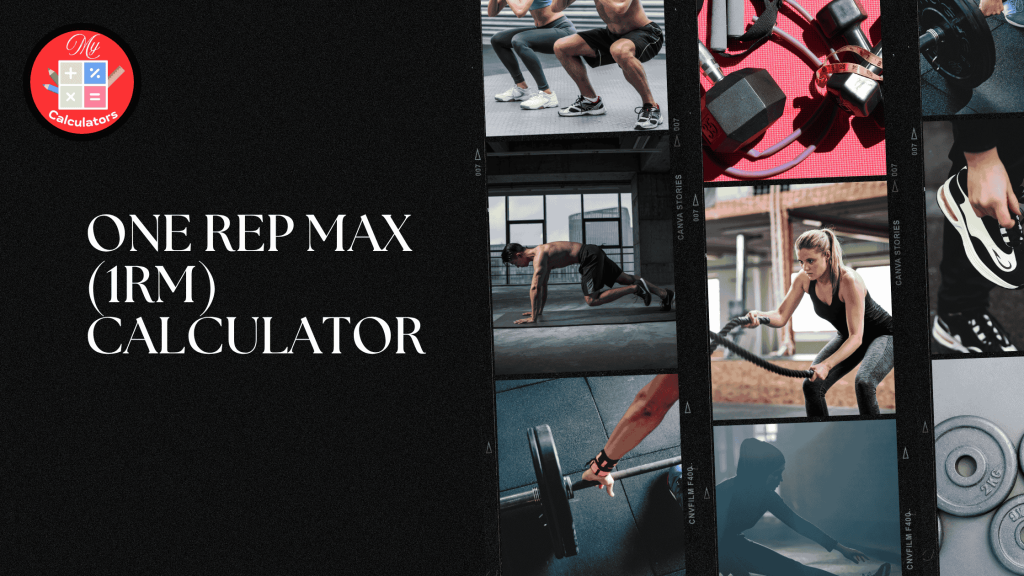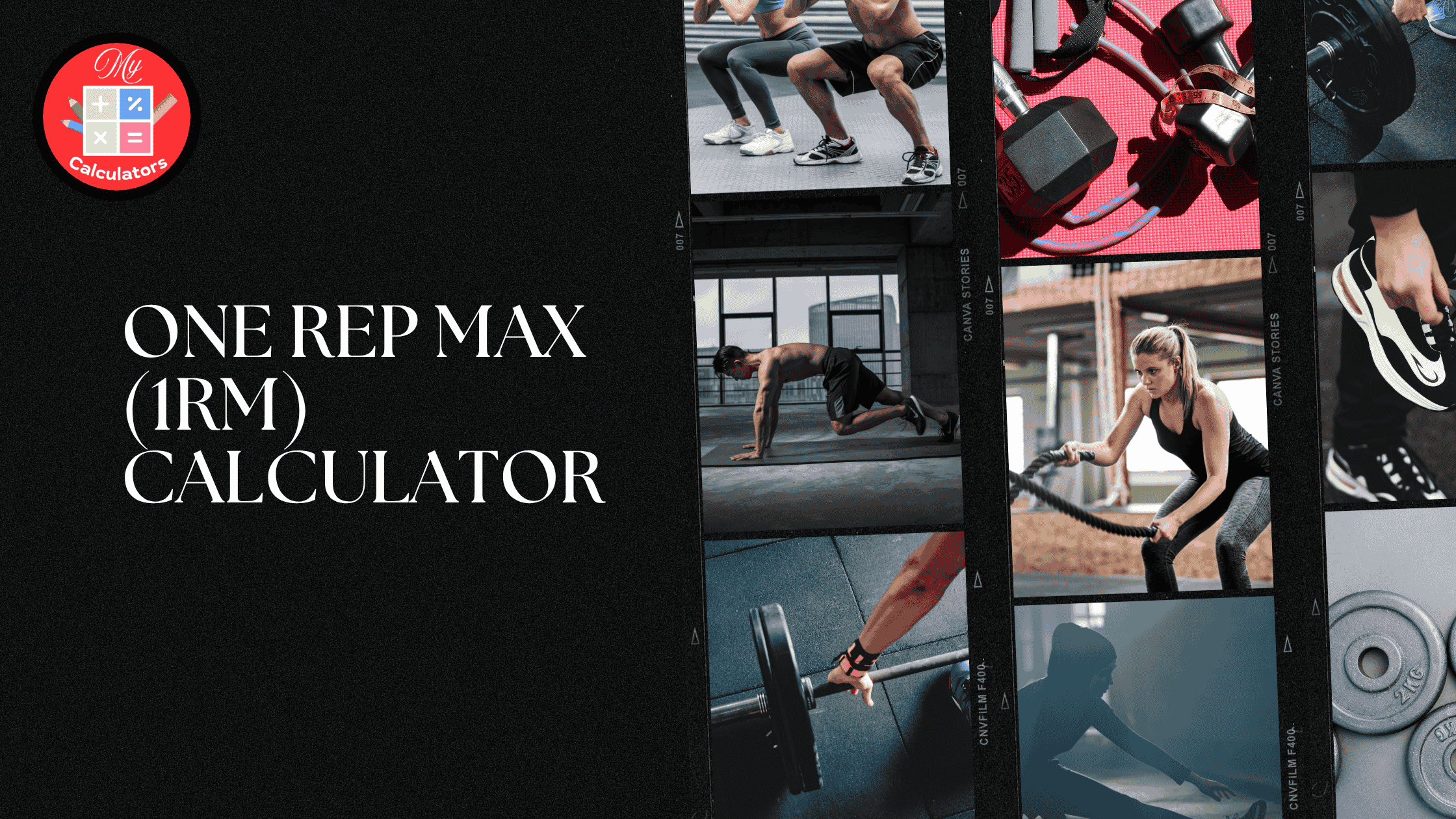Estimate your true strength with our One Rep Max (1RM) Calculator. Enter weight, reps, and lift type to calculate your 1RM using proven formulas. Train smarter with My Calculators.
One Rep Max (1RM) Calculator
When you step into a gym, one of the most common ways to assess strength is by knowing your One Repetition Maximum (1RM)—the maximum amount of weight you can lift for a single repetition of a given exercise. Whether you’re a powerlifter, bodybuilder, athlete, or just someone serious about weight training, calculating your 1RM helps you train smarter, not harder. At My Calculators, we bring you a simple and accurate One Rep Max (1RM) Calculator to estimate your maximum strength safely and efficiently.
Table of Contents

What Is a One Rep Max (1RM)?
One Rep Max, often abbreviated as 1RM, is the maximum weight you can lift for one repetition of an exercise. It is a crucial metric in strength training programs because it sets the baseline for determining appropriate loads for various training intensities:
- 85-90% of 1RM for strength
- 65-75% of 1RM for hypertrophy
- 50-60% of 1RM for endurance
Understanding your 1RM allows you to build custom workout plans that align with your training goals.
How Does the One Rep Max (1RM) Calculator Work?
The One Rep Max (1RM) calculator on My Calculators uses proven formulas to estimate your one-rep max based on:
- Weight lifted
- Number of repetitions performed
- Selected exercise type (Squat, Bench, Deadlift, etc.)
- Preferred units (kg or lb)
Instead of attempting a risky one-rep lift, you can perform a submaximal set (e.g., 5 reps at 80 kg), and our calculator will safely estimate your 1RM using formulas like:
- Epley formula:
1RM = weight × (1 + reps ÷ 30) - Brzycki formula:
1RM = weight × (36 ÷ (37 - reps))
Our tool averages multiple formulas to provide a balanced, accurate estimate.
Key Features of Our One Rep Max (1RM) Calculator
Supports Both Metric and Imperial Units
Choose between kilograms (kg) or pounds (lb) according to your training system.
Exercise Type Selector
Pick from general lifts like squat, bench press, deadlift, or input your custom exercise.
Accurate Calculations
Based on well-researched strength estimation formulas trusted by trainers worldwide.
Mobile-Friendly and User-Centric Design
Our intuitive interface ensures quick and smooth usage across all devices.
Reset Button Included
Quickly clear your input fields and perform new calculations without reloading.
Why Is Knowing Your 1RM Important?
Knowing your 1RM is not just for bragging rights. It serves several essential training purposes:
1. Programming Workouts
Most strength programs are based on percentages of your 1RM. This allows for structured progression and prevents overtraining or undertraining.
2. Tracking Progress
Retesting your 1RM monthly or quarterly helps you assess progress in strength and muscle development.
3. Injury Prevention
Rather than maxing out every week, use submax sets and the 1RM calculator to estimate your strength—this helps avoid injury.
How to Use the One Rep Max (1RM) Calculator on My Calculators
Using our tool is simple:
- Select your preferred unit (lb or kg).
- Choose the exercise type (or keep it general).
- Enter the weight lifted.
- Enter the number of repetitions performed.
- Hit “Calculate 1RM” to get your result instantly.
- Click “Reset” to start again.
Real-World Example
Let’s say you lifted 80 kg for 6 reps on the bench press:
Using the Epley formula:1RM = 80 × (1 + 6 ÷ 30) = 80 × 1.2 = 96 kg (approx.)
You now know your estimated bench press 1RM is around 96 kg—a number you can use to plan sets at 75% (72 kg), 85% (81 kg), etc.
Tips for More Accurate 1RM Estimations
- Use weights and reps that are challenging but not maximal. Ideally, 3 to 10 reps work best for estimation.
- Maintain proper form to ensure the lift truly represents your strength.
- Avoid using high-rep sets (12+) for 1RM estimation—they’re less accurate.
- Always warm up and rest adequately before your set.
Frequently Asked Questions (FAQs)
Q1. Is it safe to test my actual 1RM?
A: It can be safe under professional supervision, but it’s generally better to estimate using a calculator.
Q2. Can I use this calculator for any exercise?
A: Yes! While it works best for compound lifts like squats and bench press, it can estimate any lift with consistent form.
Q3. How often should I calculate my 1RM?
A: Every 4 to 6 weeks is ideal for tracking progress while avoiding overexertion.
Final Thoughts: Lift Smarter with the My Calculators 1RM Tool
If you’re serious about strength training, our One Rep Max Calculator is a must-have tool. It gives you the insight needed to optimize training loads, prevent injuries, and track your journey toward stronger lifts.
Whether you’re a beginner trying to find your baseline or an advanced athlete fine-tuning your routine, My Calculators provides a free, fast, and effective way to understand your real lifting potential. Check our Some other Health and Fitness Calculators:
- IPF Points Calculator
- Barbell Flex Calculator
- Macronutrient Calculator
- Vertical Leap Calculator
- BMR and TDEE Calculator
- Basketball Dunk Calculator
Start calculating your 1RM today and take control of your strength!











1 thought on “One Rep Max (1RM) Calculator – Find Ideal Strength – 2025”